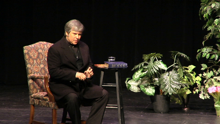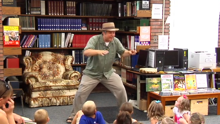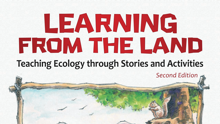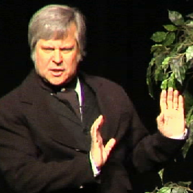By Brian “Fox” Ellis
Plant a tree, Plant a tree,
Plant a tree for you and me, Plant a Tree.
Plant a tree, Plant a tree,
For your great grand-children’s children, Plant a tree.
Imagine a thousand children singing this simple chant. Imagine giving each child a tree to take home and plant. Now imagine yourself entertaining this audience with folktales from around the world. After the assembly, can you imagine creating hands-on science stations to teach the children about caring for their trees? Now imagine that you are getting paid for doing work that truly makes the world a better place!
For the past several years I have hosted and organized Arbor Day events for communities throughout Central Illinois. This past year we put together a dozen festivals and planted more than 5000 trees! More importantly, I would like to share with you our lesson plans, budgets, and funding ideas so you can create this Earth Work in your community.
More than fifteen years ago, and for several years in a row, communities throughout the Midwest hired me to help them celebrate Arbor Day. In Detroit, I also presented hands-on science for kids, teacher workshops, and after school programs sponsored by the very successful Greening of Detroit organization.
But I was tired of planting trees in other communities and wanted to make a difference in Peoria, my hometown. Also, as a full-time teller of tales, I am always looking for ways to create work in my backyard.
I approached Peoria’s city arborist and told him of my dream. I offered to do ALL of the work if he would help us to get trees. He was excited and offered help. The first year we presented two programs on Arbor Day at two schools.
The program, though adapted slightly for each setting, has stayed the same:
1) We begin with a word from the Principal about the importance of Arbor Day and trees.
2) If we are outside, as we often are, we plant one large ceremonial tree.
3) I then tell 35-45 minutes of tree tales from around the world. I weave the stories with songs in other languages and a healthy scoop of scientific information about trees. Barry Cloyd, singer/songwriter, helps lead the singing.
4) We end the program with detailed planting instructions for the tree they will receive, including a ‘repeat after me’ pledge to water the tree the first summer.
We then send most of the students back indoors. Four classes rotate through a series of fifteen minute hands-on science stations where they learn about tree care, invasive bark boring beetles, the parts of a tree, and the ecological impact of trees. Teachers or local park naturalists can be recruited to help with the hands-on science.
 The story selection is the most important element. There are lots of fun folktales that have a tree in them, but I wanted stories that emphasize the importance of trees, include some scientific information about the life cycle or ecology of trees, and help kids connect with trees on a visceral level. You do not have to be an arborist to see that some stories have more ecological substance than others. Also, for elementary students, the stories must be fun, reflect their cultural heritage and include active participation. (See our on-line bibliography for suggestions.)
The story selection is the most important element. There are lots of fun folktales that have a tree in them, but I wanted stories that emphasize the importance of trees, include some scientific information about the life cycle or ecology of trees, and help kids connect with trees on a visceral level. You do not have to be an arborist to see that some stories have more ecological substance than others. Also, for elementary students, the stories must be fun, reflect their cultural heritage and include active participation. (See our on-line bibliography for suggestions.)
The city arborist shared our success with his peers and the next year we found funding. Our local power company gave us $1000 as a matching grant, matching the cost of the donated trees. We found a source for free trees. I continued to volunteer my time to organize the event, but the $1000 helped to pay for my performances, to print tree planting instructions and to pay three environmental educators to help with the hands-on science stations.
Our second and third year the event became easier to organize and began to garnish some attention. The local newspaper published student poems and pictures created for Arbor Day. We also created a Public Service Announcement with a song and story to raise awareness about spring tree planting. It has aired on several radio stations for potentially hundreds of thousands of listeners! We produced both a soft rock and bluegrass/country version for urban and rural radio stations.
With support from the Central Illinois Regional Urban Forestry Council and the Illinois Department of Natural Resources, we have begun presenting ten programs a year, two a day, for a full week around Arbor Day. Two years in a row, the cash strapped state of Illinois granted us $4500.
The arborists from several cities stepped up to the plate to provide large trees and help with the logistics. Principals, teachers and students are thrilled to participate in this program that is fun, educational and free to them. WE, and I could not have done it without this wonderful team, created a portable festival where we spent the week inspiring joy and a profound connection to the earth. We have planted more than 12,000 trees in the Peoria Area!
Even better news: At a recent post-event evaluation the new city arborist wondered if we could expand this to two weeks next year! We will see what dreams unfold…
My larger dream is to see dozens of storytellers organizing hundreds of festivals throughout North America. What are the facts from this tale that you can use in your community? In a nutshell:
-
Use the friends and contacts you have with principals, city officials and funding sources to help get the seeds sprouted.
-
Contact your city Arborist. To be an official Tree City towns are required to have a tree planting event and are glad to have your help.
-
Several states require power companies and waste management companies to do this kind of ecological remediation and are happy to fund a well planned program that educates and plants trees.
-
Look for tree stories that include ecological themes.
-
Storytelling is a great educational tool, but science should be a verb. The hands-on science is a valuable piece of the event.
-
Nature center staff members are great at the science and not very expensive, sometimes free to you because this is part of their daily responsibility.
-
Including schools from different neighborhoods, different cultural, ethnic and socio-economic backgrounds, makes it easier to get funding.
-
Start small and build it, one school this year, one day next year, one week the following year.
-
You do not have to re-invent the wheel. See what others have done and borrow the ideas that work for you.
If you would like to organize Arbor Day or Arbor Week for your community, get started now to lay the groundwork for next year. Visit www.arborday.org, www.treesforever.org, www.spiritoftrees.org, or my web page, www.foxtalesint.com, for more information. Send me an e-mail with “Arbor Day Festival” in the subject line and I will gladly send you our detailed budget/grant form, press releases, lesson plans and tree planting instructions.
Plant a tree, Plant a tree,
For your great grand-children’s children, Plant a tree!

 The story selection is the most important element. There are lots of fun folktales that have a tree in them, but I wanted stories that emphasize the importance of trees, include some scientific information about the life cycle or ecology of trees, and help kids connect with trees on a visceral level. You do not have to be an arborist to see that some stories have more ecological substance than others. Also, for elementary students, the stories must be fun, reflect their cultural heritage and include active participation. (See our on-line bibliography for suggestions.)
The story selection is the most important element. There are lots of fun folktales that have a tree in them, but I wanted stories that emphasize the importance of trees, include some scientific information about the life cycle or ecology of trees, and help kids connect with trees on a visceral level. You do not have to be an arborist to see that some stories have more ecological substance than others. Also, for elementary students, the stories must be fun, reflect their cultural heritage and include active participation. (See our on-line bibliography for suggestions.) 








